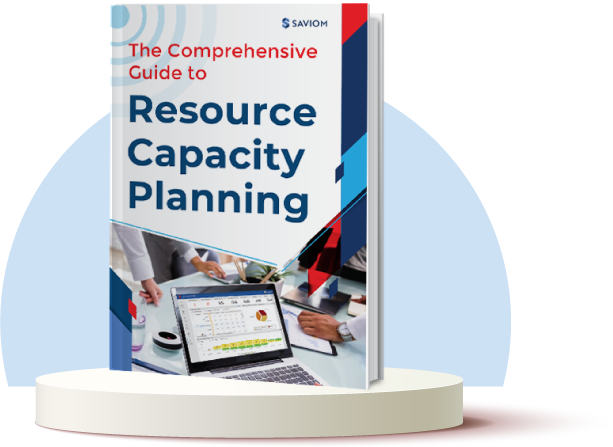Are resource shortages constantly throwing your projects off track?
Do you often end up with more resources than needed, leading to unexpected cost overruns?
Is it a constant struggle to strike the right balance between resource availability and upcoming demand?
If it’s a resounding YES, it’s a clear sign of an imbalance between supply and demand. Many organizations face this challenge, often due to a lack of visibility into future workload and available capacity. This is where capacity report becomes essential.
Capacity reports provide a clear picture of how well your existing resources are aligned with the future and pipeline opportunities. By reviewing these reports regularly, you can identify potential gaps like shortage/excess well in advance. This enables forward planning, smoother project execution, and timely allocation of resources.
In this blog, we will understand about capacity report, its types, benefits and how to build a robust one in your firm.
Let’s begin.
What is Capacity Report?
A capacity report, also called capacity planning report is a document that outlines a firm’s resource capacity against current and future project demands. By tracking various resource metrices like utilization rates, workload, and scheduled hours, the report highlights potential workforce shortages and excess in advance.
Typically, the report is expressed in hours or percentages and enable firms to gain a holistic view into operational capacities. This further helps them take informed decisions and mitigate any resource-related risks that could disrupt timely project initiation.
So, to summarise here is what it helps you figure out:
- Can we deliver ongoing work with the people we have?
- Who’s overloaded or not being utilized enough?
- Are there available resources for unscheduled confirmed work?
- Do we need to hire soon or shift things around?
- What kind of work can we realistically commit next?
Now, let’s see the various types of capacity report.
Types of Capacity Report
Listed below are the types of capacity report:
Resource Capacity Report
A resource capacity report outlines whether an organization has enough workforce or equipment to meet present and upcoming business demands. It highlights the resource availability and utilization levels by monitoring metrics such as team capacity, utilization levels, scheduled vs billable hours, planned time off, etc. These insights help firms take corrective measures and facilitate proper project planning.
Workload Capacity Report
As the name suggests, this report outlines workload distribution across teams and individuals, thereby identifying imbalances like resource over or underutilization. With access to this real-time data, managers can redistribute tasks, adjust project timelines, or offer additional support to keep workloads balanced. This helps maintain productivity without overwhelming the team.
Read More: Signs of Resource Underutilization and (how to) Course Correct Them
Project Capacity Report
This report provides an overview of the available resources and their capacity required for specific projects, helping managers allocate them accordingly. It further allows managers to assess whether firms have enough bandwidth to take on additional projects and subsequently determine potential resource risks, that may disrupt project flow.
Now that we know the definition of capacity report and its types, let us move on to the benefits of it in a firm.
Benefits of a Capacity Report in Your Firm
Utilizing capacity planning reports offers several strategic and operational advantages that improve overall project resource management. So, here are some crucial benefits of the capacity report –
Supports Budget Planning and Cost Control
A capacity report provides a clear picture of resource capacity against demands, helping businesses avoid unnecessary costs. By anticipating workforce needs in advance, it gives managers enough time to strategically source and assign cost-effective local/global resources and minimize last-minute hiring expenses. Ultimately, this helps maintain both financial and project efficiency.
Read More: How to Create an Effective Hiring Strategy
Bridges Capacity vs. Demand Gap
A capacity report helps mitigate gaps between resource capacity and demand by identifying imbalances, i.e., shortage or surplus. In case of shortages, managers can plan training/upskilling or recruitment efforts, and if there’s an excess, managers can bring forward project timelines or sell extra capacity at discounted rates. This reduces operational risks and ensure timely initiation of projects.
Facilitates Better Resource Planning
By using capacity reports, managers gain a comprehensive view into workforce availability and resource utilization levels across teams and projects. These data-driven insights allow them to plan resources effectively by considering factors like workload distribution, underutilization, and schedules. Thus, they can align right people to right tasks, optimize performance, and meet project deadlines on time.
Read More: What is Resource Planning, and Why is it Important in Project Management?
Improves Training & Hiring Decisions
A capacity report helps identify skill gaps and resource shortages based on current and projected project demands. This enables managers to make informed decisions regarding skill development, training initiatives, or targeted hiring. Thus, firms can ensure the team is equipped with the right skills when needed. Over time, it helps build a more agile, capable, and future-ready workforce.
Given above are the benefits, let us move now move on to the steps to build a capacity report manually.
6 Steps to Build a Capacity Report Manually
It is very important to build a robust capacity report to get a clear view of resource capacity versus project demand. Here are six simple steps to create one manually –
Define the Purpose
Firstly, organizations must decide whether to evaluate overall workforce capacity or focus on a specific team, such as finance, IT, or sales. Then, they must set a clear scale which is weekly, monthly, or quarterly, to ensure the report aligns with business needs and helps track capacity.
For example, if the goal is to assess a team’s ability to handle upcoming projects, the report should focus on availability, task duration, and scheduling conflicts. If the aim is to identify company-wide shortages, it should highlight each department’s current capacity and gaps.
Identify Key Metrics for Capacity Measurement
Choosing the right metrics ensures a capacity planning report provides meaningful insights. Key indicators include billable resource utilization, workload distribution which determine if they are over/under utilized, and available hours. These metrics vary by industry, aligning with business needs and workplace dynamics.
For example, for a capacity report for an IT project team, managers might track each member’s total weekly hours, how many are already allocated, and the remaining availability. So, if a person has 40 available hours and 30 are booked, their utilization rate is 75%, leaving 25% capacity for new tasks.
Read More: What is Capacity Requirement Planning, and Why is it Important?
Gather Accurate and Relevant Data
Accurate data is the backbone of a reliable capacity report. This next step involves collecting up-to-date information on available working hours of project resources, current workloads, project timelines, and resource schedules. These data can be collected from various sources like timesheets or resource management software.
For example, if a team member is scheduled for 40 hours but has two days of planned leave, their capacity should be adjusted to 24 hours. Likewise, hours blocked for training or meetings should be excluded from available capacity to ensure accuracy and precise picture of resource availability.
Assess Current Capacity Levels to Identify Gaps
After gathering data, the next step is to compare capacity against demand. This involves evaluating whether available resources align with project requirements. A capacity vs. demand gap analysis highlights shortages or excess capacity, helping managers plan workforce adjustments.
For example, if a team member has 40 available hours in a week but is already assigned 45 hours of work, there’s a capacity gap of -5 hours, indicating a resource overallocation. On the other hand, if another team member has only 20 hours assigned, they have 20 unused hours that could be better utilized.
Read More: What is Resource Capacity Planning? An Ultimate Guide for Every Project Manager
Develop Actionable Insights and Recommendations
Next, managers can implement necessary measure to bridge capacity and demand effectively. If managers find out that there are resource shortages, they can initiate training/upskilling programs, implement out rotation/backfill strategies, or hire a permanent or contingent workforce based on project duration.
On the other hand, if there is an excess of resources, managers can bring forward project timelines or sell the additional capacity at discounted rates. Thus, implementing solutions according to resource bottlenecks will help firms to avoid last-minute firefighting, budget overruns, and project failures.
Present and Communicate the Report
Once the capacity planning report is built, the next step is to present it to the right stakeholders such as project managers, department heads, or senior leadership. The aim is to translate and communicate raw data into clear insights around capacity versus demand, highlighting what’s working well and what’s not.
The report should include visual aids like Gantt charts, graphs, and tables to highlight key metrics, trends, capacity gaps, and recommended actions. It’s also important to provide context around the data, such as project timelines, team workloads, and potential risks, so stakeholders can make informed choices.
Next, let us see how a resource management software helps in analyze a capacity report effectively.
How to Assess a Capacity Report?
SAVIOM’s 5th gen resource management software offers advanced capacity report that help managers track and assess capacity against demand to make informed decisions accordingly.
The tool features an integrated all-in-one Resource Planner that allow managers to quickly analyze capacity, utilization, and availability across various dimensions like role, region, department, project, etc., to quickly identify any potential gaps.
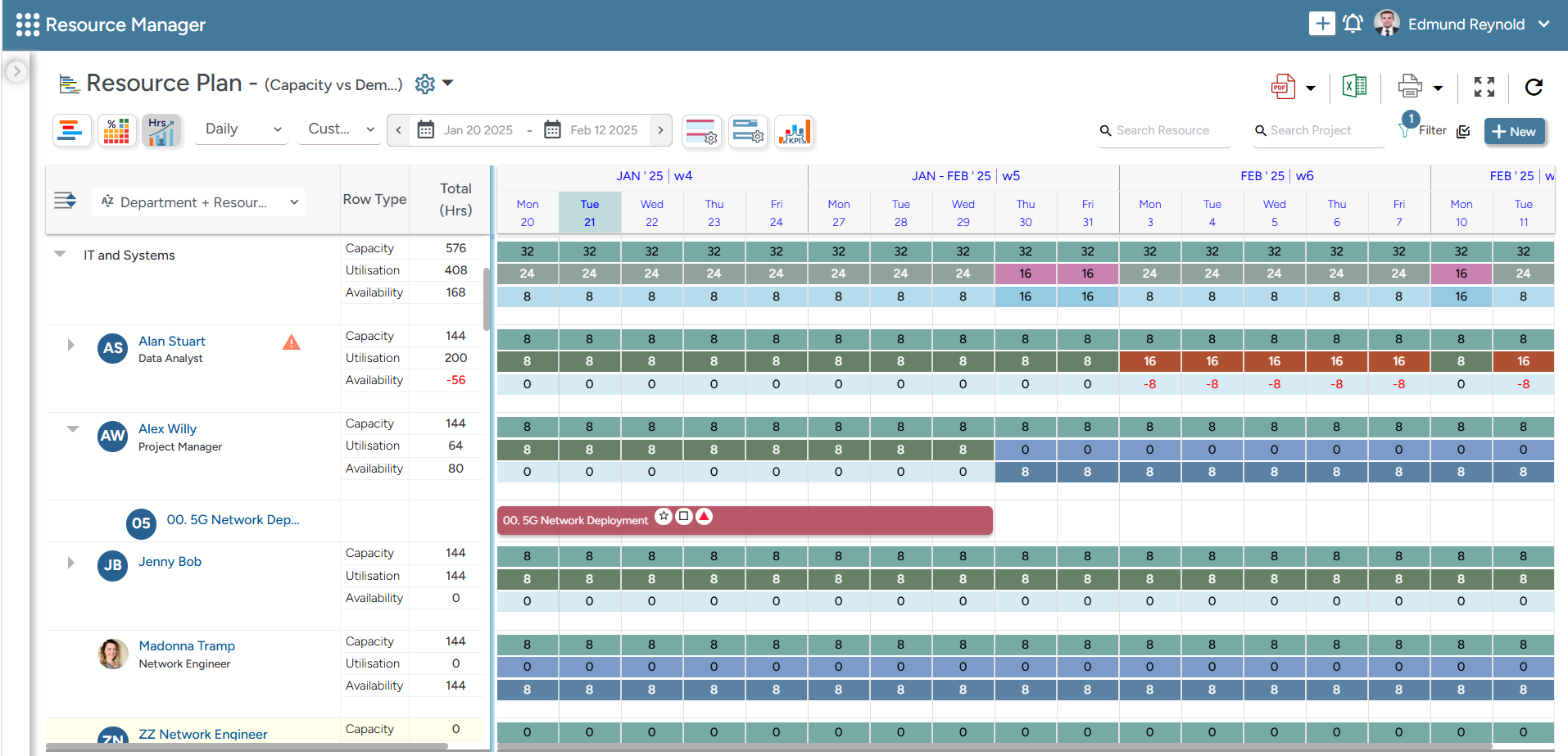
But beyond this, the tool offers real-time capacity report that offers deep insight into capacity and demand. Let us understand it in detail –
Visualizing the Report: Tabular and Graph Format
The data in the capacity vs. demand report can be displayed in graphical, tabular, or combined views, giving managers visual clarity as well as numerical precision. Further, the software offers flexible group-by options where users can group resources by attributes like location, primary role, department, and more. This helps in filtering data based on what’s most relevant to your planning needs.
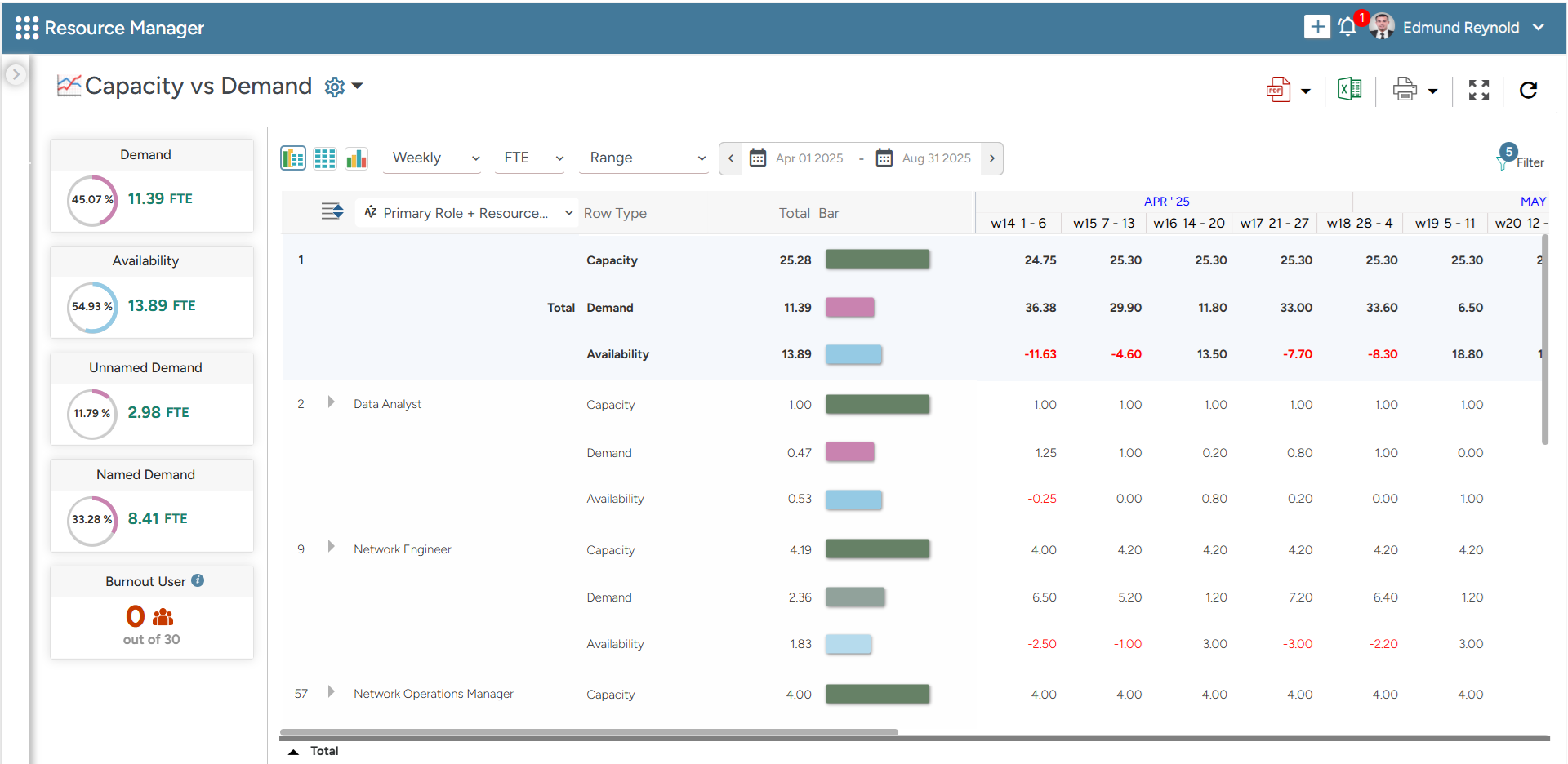
As shown in the image above, each resource’s availability, capacity, and demand are clearly displayed. So, if there’s a shortage or overbooking, the system automatically flags it with negative values in red, giving an early warning to managers so they can act before issues escalate.
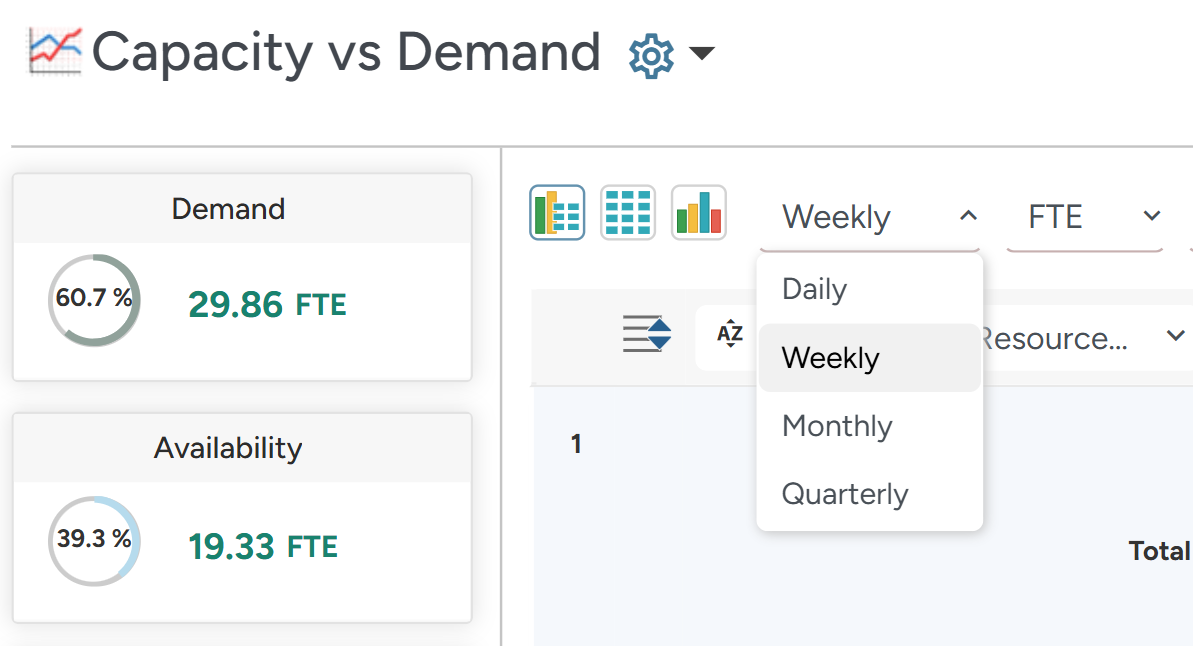
Users can also select the time granularity of the report as shown in the image above. They can see the data on a daily, weekly, monthly, or quarterly basis, giving a better picture of the information over different periods.
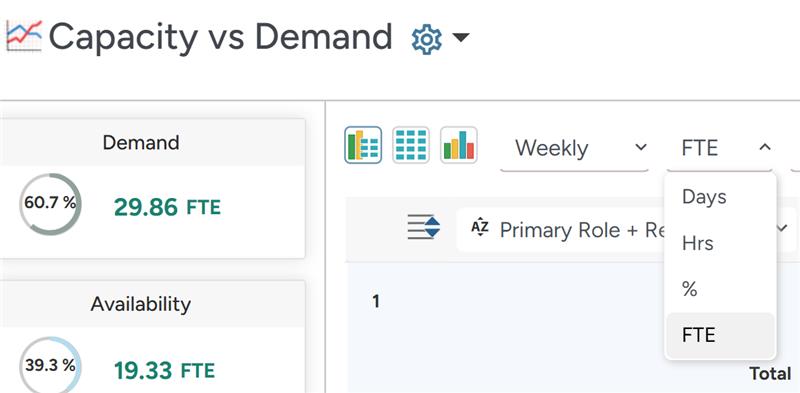
Additionally, users can also pick the unit in which they want the capacity to be shown, such as FTE (Full-Time Equivalent), days, hours, or percentage.
Read More: How Can You Make Data-Driven Decisions with Resource Management Software?
Final Thoughts
A well-structured capacity report empowers organizations to align their resources with business demands effectively. It enables proactive planning, minimizes resource-related risks like shortage/excess, and supports informed decision-making. Therefore, it lays the foundation for smarter planning and better resource decisions.
Is your organization ready to build a capacity report that truly drives better organizational efficiency?
The Glossary
Read More: Glossary of Resource Workforce Planning, Scheduling and Management





